4530.0 - Crime Victimisation, Australia, 2011-12  Quality Declaration
Quality Declaration
ARCHIVED ISSUE Released at 11:30 AM (CANBERRA TIME) 19/02/2013
Page tools:
 Print Page Print Page
 Print All Print All
| ||||
PHYSICAL AND THREATENED ASSAULT PHYSICAL ASSAULT Physical assault is an act of physical force or violence by a person against another person. Examples of physical force or violence include being pushed, grabbed, shoved, slapped, kicked, bitten, choked, shot, burnt, being hit with something such as a bat or being dragged or hit deliberately by a vehicle. It includes assault which may happen in the line of work. It excludes incidents that occurred during the course of play on a sporting field or organised sport, verbal abuse, incidents where the person did not encounter the offender face-to-face and incidents of sexual assault or threatened sexual assault which also involved physical assault. During the 12 months prior to interview, there were an estimated 2.2 million incidents of physical assault in Australia, experienced by 539,800 victims (3.0% of the population). Nearly half (49%) of victims of physical assault had the most recent incident they experienced reported to the police. 2011-12 Physical Assault Victimisation Rate, by State and Territory 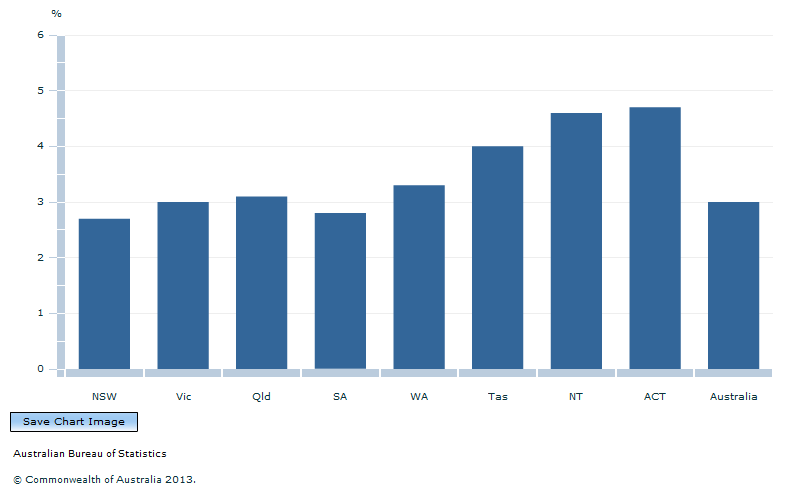 Source(s): Crime Victimisation, Australia The victimisation rates for physical assault in the Northern Territory (4.6%) and the ACT (4.7%) were higher than the national average (3.0%), as well as being higher than NSW (2.7%) and South Australia (2.8%). Victims of physical assault were less likely to live in capital cities than they were in the rest of Australia. The victimisation rate for physical assault in capital cities was 2.8%, which was lower than the victimisation rate for the rest of Australia, at 3.3%. 2011-12 Rate of Reporting of Physical Assault Reporting to Police, by State and Territory 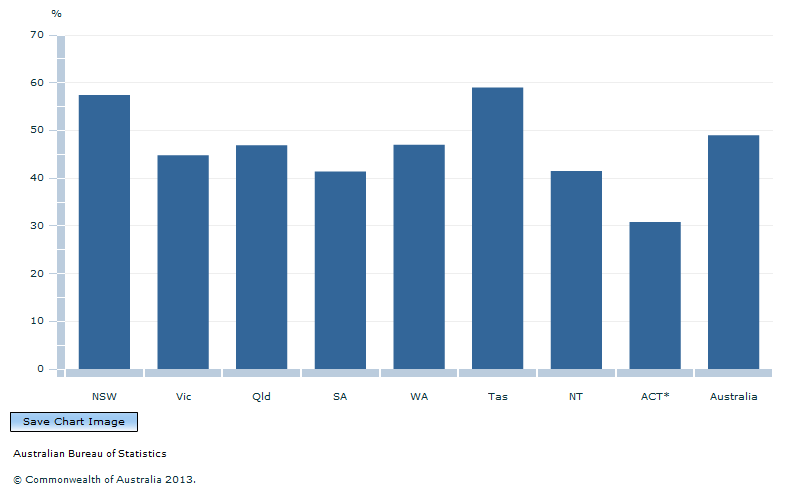 Source(s): Crime Victimisation, Australia Footnotes * The estimate for physical assault reporting rate for the ACT has a relative standard error between 25% and 50% and should be used with caution. The reporting rate for physical assault in NSW (57%) was higher than the national average (49%). Victims in NSW were also more likely to report the most recent incident of physical assault they experienced to police than those in South Australia (41%) and Victoria (45%). THREATENED ASSAULT Threatened assault is a verbal and/or physical threat to inflict physical harm, where the person being threatened believed the threat was able and likely to be carried out. Threatened assault may occur face-to-face or via non face-to-face methods (such as email). Threatened assault includes any threat or attempt to strike the person which could cause pain and situations where a gun was left in an obvious place (including fake or toy guns where the victim thought it was real) or if the person knew the perpetrator had access to a gun. It also includes incidents where the person was threatened in their line of work. Threatened assault excludes any incident of name calling or swearing which did not involve a physical threat and threats that resulted in an actual assault. Face-to-face threatened assault includes any threats that were made in person. It excludes any incident where the victim did not encounter the offender in person (for example, telephone calls). Non face-to-face threatened assault is where the person did not encounter the offender in person. Non face-to-face threatened assault may occur through mediums such as the telephone, text message, e-mail, in writing or through social media. In the 12 months prior to interview, an estimated 4.4 million incidents of threatened assault were experienced by 667,700 Australian aged 15 years and over (3.7%). There were 2.9 million incidents of face-to-face threatened assault experienced by 596,000 victims (3.3% of the population) and approximately 1.5 million incidents of non face-to-face threatened assault experienced by an estimated 213,100 victims (1.2% of the population). Nearly four in five (38%) victims of face-to-face threatened assault had the most recent incident they experienced reported to the police and around three in ten (29%) victims of non face-to-face threatened assault had the most recent incident they experienced reported to the police. The victimisation rate for face-to-face threatened assault in Western Australia (4.1%) and the Northern Territory (6.8%) was higher than the national average (3.3%). People in Western Australia (4.1%), the Northern Territory (6.8%) and Tasmania (4.4%) were more likely than those in NSW (2.9%) and Victoria (2.9%) to be a victim of face-to-face threatened assault. 2011-12 Face-to-Face Threatened Assault Victimisation Rate, by State and Territory 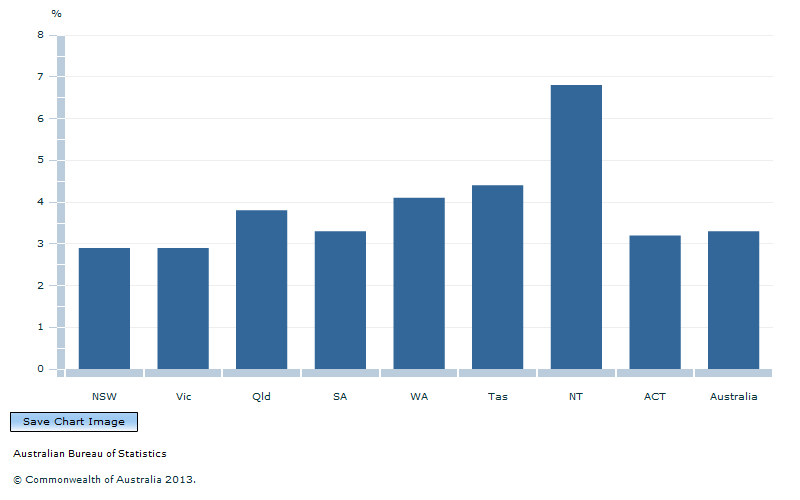 Source(s): Crime Victimisation, Australia The victimisation rate for non face-to-face threatened assault for NSW (0.9%) was lower than the national average (1.2%) and the rate for Tasmania (2.6%) was higher than the national average. People in Tasmania were more likely to be a victim of non face-to-face threatened assault than any other state, apart from the Northern Territory (1.5%). 2011-12 Non Face-to-Face Threatened Assault Victimisation Rate, by State and Territory 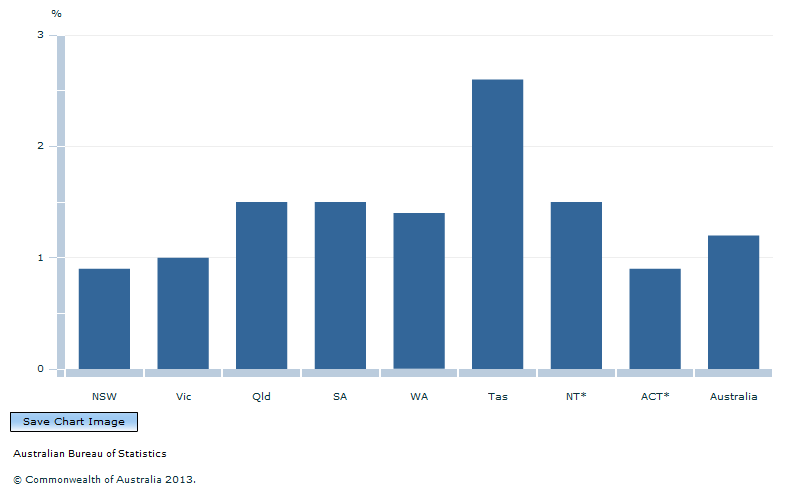 Source(s): Crime Victimisation, Australia Footnotes * The estimates for non face-to-face threatened assault victimisation rate for NT and ACT have a relative standard error between 25% and 50% and should be used with caution. Victims of face-to-face and non face-to-face threatened assault were less likely to live in capital cities than in the rest of Australia. The victimisation rates for face-to-face and non face-to-face threatened assault were 2.9% and 1.0% respectively for the capital cities, which was lower than the victimisation rates for the rest of Australia, at 3.9% and 1.5%. Forty-five per cent of victims of face-to-face threatened assault in NSW had the most recent incident they experienced reported to police. This was higher than the rate of reporting to police for victims of face-to-face threatened assault in Victoria (32%). 2011-12 Rate of Reporting of Face-to-Face Threatened Assault to Police, by State and Territory 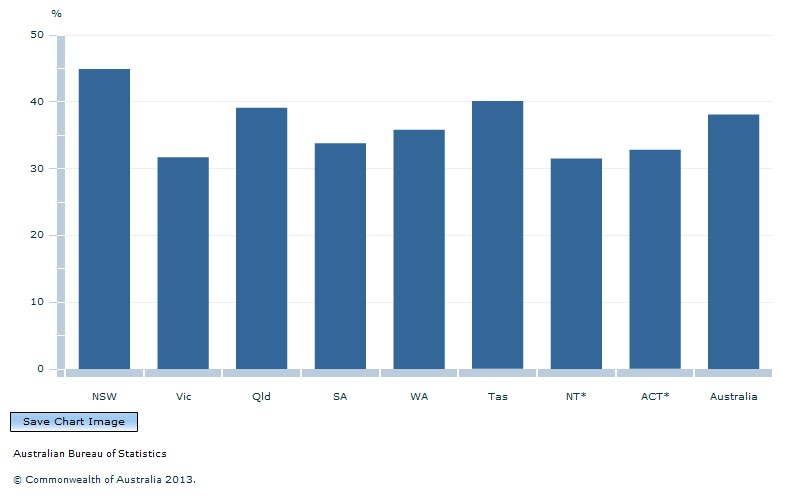 Source(s): Crime Victimisation, Australia Footnotes * The estimates for face-to-face threatened assault reporting rate for NT and ACT have a relative standard error between 25% and 50% and should be used with caution.
|
||||
